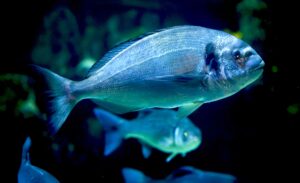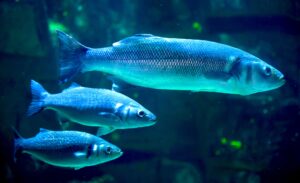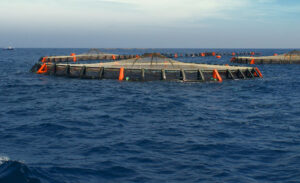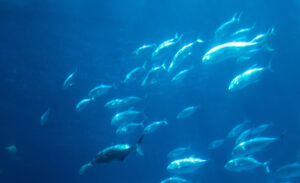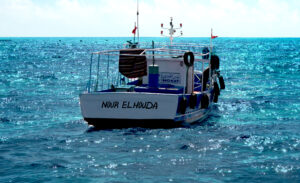Where do sea bass live?
Sea bass is a marine fish that lives in the Mediterranean Sea and the northeast Atlantic Ocean, particularly in the temperate zone of northern Europe up to Senegal. It is also present in the Black Sea, but not in the other Asian marine areas of the White Sea, Baltic Sea, and the Caspian Sea.
The sea bass is a species that lives mainly in coastal areas and adapts well to different environments. It is not uncommon to see it in the brackish zones of river mouths and lagoons, with sandy and rocky bottoms. Young specimens even prefer brackish areas before venturing into the sea as adults. This characteristic, called euryhalinity, distinguishes the bass, and allows it to adapt to different intensities of water salinity.
The sea bass lives at shallow depths that rarely reach a hundred meters, but they prefer to migrate to deeper waters in winter.
The sea bass feeds mainly on or near the seabed but is found there exclusively for this function. It usually swims and moves actively in the marine element.
What does a sea bass look like?
On average, the sea bass is about 50 cm long, but it can reach up to one meter in some specimens. Its shape is pretty tapered, but not very flattened on the sides. Its head is also elongated, and its straight forehead is one of its characteristics. Females are only slightly larger than males.
Its mouth is significant, and its jaw is slightly protruding. It has two dorsal fins, and one anal fin, while the caudal fin that stabilizes it ends in an almost straight line.
The surface of the bass has small silver scales that may have blue, green, or gold highlights.
It has a different coloration between the lower and upper parts, typical of nektonic organisms, which allows it to camouflage itself effectively. The lighter lower part allows, when seen from below, to blend in with the brightness of the surface. The darker upper part is suitable for blending in with the darkness of the depths when viewed from above.
The life of the sea bass
Adult sea bass don’t live in schools, but preferably alone or in pairs, and can live up to 30 years. It is a species that does not move much from its territory, and rarely migrates to areas other than where it lives. It hunts mainly at night, and is very sensitive to the moon’s phases and the variation of the tides.
It does not seem to fear the presence of man much, as evidenced by the many divers they approach, despite the interest they arise in fishers.
Sea bass feed on mullets, eels, and other small fish, while juveniles feed on invertebrates and molluscs. In the North Atlantic, the favourite food of the sea bass is the sand crab, which is very common there.
Sea bass reproduction
Sea bass reaches sexual maturity after 2-4 years in warmer waters, and between 4-8 years in colder ones. It lays its eggs once a year, in winter in the warmer seas, and spring in the more northerly zone, and they remain floating on the water’s surface due to the presence of a minimal amount of oil.
The eggs hatch in about three days, and larval development proceeds for the next 40 days.
In the particularly warm waters of the Adriatic Sea, the spawning period for sea bass begins when the water temperature reaches 14°C.
Sea bass fishing
The sea bass is a prized species and highly appreciated for its tasty meat with very few bones. For this reason, it is much sought after by fishermen, both amateur rod anglers, and divers, as well as for commercial fishing.
It is fished using various techniques, from bait fishing to trolling. In spearfishing, the ease of approaching the bass favours more natural fishing techniques with sound calls, or by waiting for the fish in the tidal backwash where it likes to hunt.
The delicacy of its meat is also particularly appreciated in raw preparations, when the sea bass is caught on hook, when the sea is clean, especially in the Venice lagoon area.
Sea bass farming
Sea bass is a fish consumed mainly in southern Europe. It’s in the Mediterranean basin that most sea bass farming facilities are concentrated. The major producing countries are in the Mediterranean Sea: Greece, Turkey, Italy, Spain, Croatia, Tunisia, and Egypt. In some of these, the bass is the predominant species in this sector. In northern European countries, sea bass is mainly consumed in ethnic restaurants, as it is considered an exotic product.
The breeding of sea bass is carried out through aquaculture. This technique circumscribes a specific sea area where the fish species can grow in the most natural environment possible.
In this respect, there are different types of installations, from those that merely control the species’ growth with feeding on the available natural resources, to those with high-intensive productivity. The difference lies in the density of energy flows needed to maintain balance.
Extensive aquaculture extends over large dimensions precisely to ensure the necessary nutrition, mainly in lagoon areas that facilitate its management. This type of farming is the one that allows the ecosystem to be preserved, and offers the fish a natural environment to grow in. Above all, it is the method that keeps all the natural qualities and provides the best product.
Intensive facilities intervene to provide food beyond the natural availability, allowing a higher fish population density. These plants need to interfere with constant water changes to keep the water sufficiently filtered. The recycling of slag requires different types of processing, so the plants must be equipped with sophisticated equipment and constant controls. However, it is possible to supply more fish, so as to maintain a more competitive price.
This concept, taken to an even higher level of fish population density, is called hypertensive. In these facilities, in addition to the constant change of water, and the continuous supply of prepared food, it is necessary to equip the tanks with regular environmental controls, such as for temperature, pH, oxygen, and many other factors.
The modern fish industry, which requires ever-increasing quantities of product, can reproduce the biological processes of the natural environment in a small space, while trying to keep the level of the organoleptic quality of the product as high as possible.
